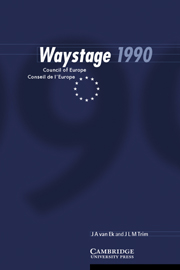Book contents
- Frontmatter
- Contents
- Preface
- Introduction
- 1 The objective: description
- 2 Components of the specification
- 3 Language functions
- 4 General notions
- 5 Themes and specific notions
- 6 Dealing with texts: reading and listening
- 7 Writing
- 8 Sociocultural competence
- 9 Verbal exchange patterns
- 10 Compensation strategies
- 11 Learning to learn
- 12 Degree of skill
- APPENDICES
- A Pronunciation and intonation
- B Grammatical summary
- C Word index
B - Grammatical summary
Published online by Cambridge University Press: 01 March 2010
- Frontmatter
- Contents
- Preface
- Introduction
- 1 The objective: description
- 2 Components of the specification
- 3 Language functions
- 4 General notions
- 5 Themes and specific notions
- 6 Dealing with texts: reading and listening
- 7 Writing
- 8 Sociocultural competence
- 9 Verbal exchange patterns
- 10 Compensation strategies
- 11 Learning to learn
- 12 Degree of skill
- APPENDICES
- A Pronunciation and intonation
- B Grammatical summary
- C Word index
Summary
Introduction
This summary presents a classified inventory of the grammatical categories, elements and structures which figure as exponents of the functional and notional categories set out in Chapters 3–5.
The order of presentation is ascending. That is to say that we first present grammatical information at the word level, classified according to the traditional part of speech with which we expect most users to be familiar. Information is provided concerning the forms of words. Sub-classes are established in terms of the types and functions of words in the major classes set up. Phrases and clauses are then classified according to their formal structure and functional roles in the sentence. Finally, sentences are classified according to their structure and functions. At all points cross reference is made to the relevant sections of Chapters 3, 4 and 5. The same form of reference is used as that employed in the word index, i.e. first the chapter, then the section and sub-sections into which the chapter is divided. So for example, 4.3.2 refers to Chapter 4, section 3.2. Examples are given, using only vocabulary items which figure in the word index.
The summary is not conceived as a teaching or reference grammar of English, but as a guide to the resources to which a learner has access as a result of learning English to Waystage.
Many critics of the original Waystage appear to have formed the impression that the functional and notional organisation adopted implied a neglect of grammar.
- Type
- Chapter
- Information
- Waystage 1990Council of Europe Conseil de l'Europe, pp. 75 - 94Publisher: Cambridge University PressPrint publication year: 1999



